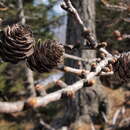European larch is an introduced deciduous conifer. Mature height
usually ranges from 30 to 130 feet (9-40 m) in the United States and
Canada; larger individuals have occasionally been reported, particularly
from Europe (up to 177 feet [54 m]) [
10,
17]. The needles are spirally
arranged in fascicles of 30 to 65 needles, on short shoots. The bark of
young trees is thin, smooth, developing fissures as it matures. On
older trees the bark is very flaky and heavily ridged with wide fissures
[
14,
15]. In the Alps, the bark at the base of very old trunks is up to
1 foot (30 cm) thick [
3]. The crown of young trees is symmetrical,
open, and narrowly conic. Old trees often have large, buttressed low
branches that run level for 8 to 10 feet (2.4-3 m) before turning upward
[
10,
15]. European larch is characterized as deep-rooted [
25].
European larch exhibits rapid early growth and occasionally early
senescence (at 30 to 40 years of age), particularly in mixed stands.
The average age at senescence is between 100 and 150 years of age [
10];
ages of 600 years or more have been reported for European larch in the
Alps [
3,
25]. The oldest European larch on record was 672 years old in
1955. Record height for European larch is reported as 184 feet (56 m)
for a specimen in Baden, Germany [
25].

